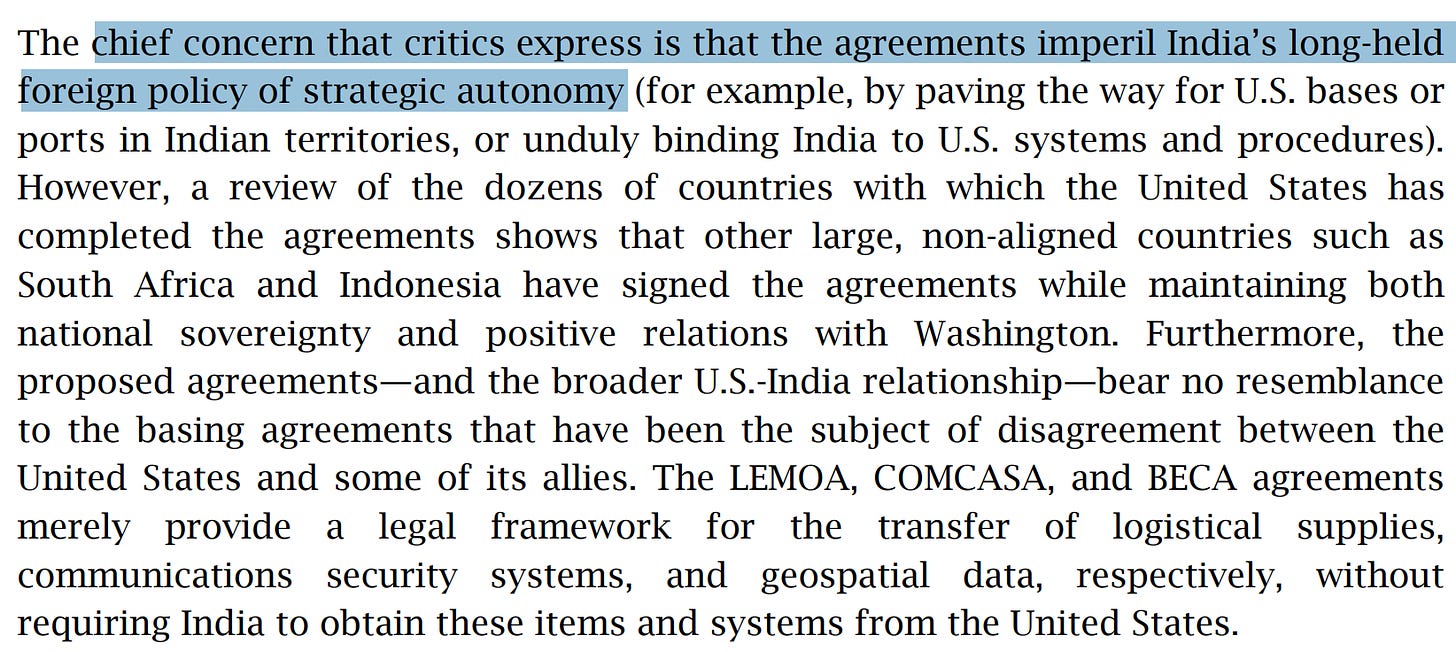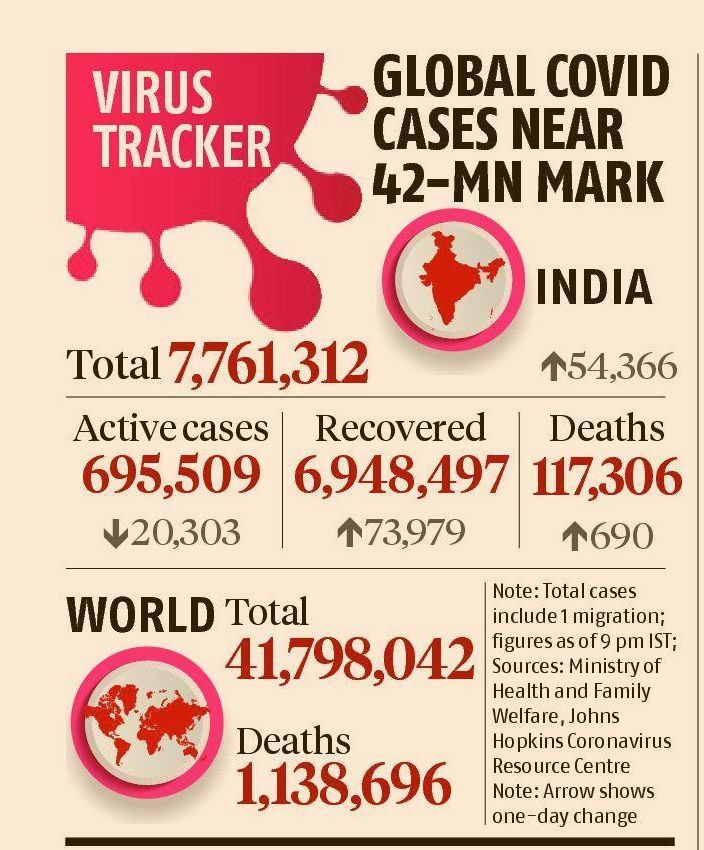Insightful newsletter of Drishtikone: Issue #164 - The Saga of LEMOA, COMCASA, and BECA

(Image by Xavier Espinosa from Pixabay)
To live is the rarest thing in the world. Most people exist, that is all.” ― Oscar Wilde
One still remembers the Indian batsmen of the 70s and 80s who would shiver and tremble in front of the fast bowlers from West Indies, Pakistan, and Australia. The speeds they would bowl at were the same at which almost every decent opening fast bowler bowls now in IPL.
All this started changing when a little 16-year-old kid walked out in one ground after another thrashing those fast bowlers with refreshing disdain. That was Sachin Tendulkar.
The problem was never in the bowling or the bowler. The problem was in the batsmen’s severe under-estimation of their own capabilities and over-estimation of the bowler who would come menacingly. They were not facing the balls. They were facing the persons.
They had a history to contend with. A history that made them meek. There was a time when Gavaskar would not hit a lofted shot. The only century he scored in the ODIs was full of those which were hit more with an attitude of “I don’t care anymore”.
You could either be a trembling Vengsarkar, a carefully great but circumspect Gavaskar, or a swashbuckling Tendulkar who used his capability and a healthy attitude of domination over anyone in the field.
India’s geopolitical maturity and diplomatic sagacity, or earlier lack of it, has mirrored the change that happened in our society from weak-minded batsmen to Tendulkar and now, Rohit Sharma.
If we have to survive in the world, we have to face the balls. If we cannot, then we shouldn’t even be on the field. But you cannot be on the pitch and then complain that the bowler is dangerous. He is not dangerous. You are either compromised or just way too weak! We will look into what all our weaknesses and mental obstacles and social stupidities have cost us!
Today we crossed a thousand subscribers to this newsletter. It was started on May 6th, 2020 just for the heck of it. It was quite basic to start with but has picked on a life of its own in the subsequent months. You can see all the issues here - Archives. Each one was carefully crafted and written with a lot of dedication.

We started off on the Revue platform and then moved to Substack. Both are great places, although Substack has a greater community of writers. Revue had better tools for a newsletter writer in my view though, making it very convenient to compose the newsletter. What started off in terms of convenience, was soon jettisoned and we opted for a detailed long format. Tough but more enriching in the end. So, if you want to start a newsletter of your own, you can check either of these platforms out.
the saga of the India-US defense agreements - detailed review
On October 27, 2020, the US and India are set for a 2 + 2 ministerial dialog. They will sign the Basic Exchange and Cooperation Agreement for Geo-Spatial Cooperation (BECA). This agreement will give India access to the much needed and highly accurate geospatial data.
What is BECA?
It is the final of the three basic agreements that the US signs with close partners, enabling interoperability of forces and exchange of sensitive and classified information. While the other two relate to sharing military logistics and enabling secure communications, BECA is aimed at sharing geospatial information, including nautical and aeronautical charts. The complete data, supplemented by highly accurate US satellites, aids in navigation as well as targeting military assets. (Source)
Why is this data so important for India at this time? And what does it provide to the Indian forces in the time of war or attack?
“Data received under the agreement will be useful for long-range navigation and missile-targeting with enhanced accuracy. Given the current geo-political situation, this data will be relevant on both the northern and western borders of India. As this is a bilateral agreement, India will also be expected to share similar data with the US,” Captain Vikram Mahajan (retd), director, Aerospace and Defence at USISPF says (Source)
BECA is not a stand-alone agreement. It is the culmination of three foundational agreements that enable India to access military intelligence that is highly accurate and strategic in nature.
The three agreements are the Logistics Exchange Memorandum of Agreement (LEMOA), the Communications Compatibility and Security Agreement (COMCASA), and the Basic Exchange and Cooperation Agreement (BECA) for Geospatial Intelligence.
LEMOA was signed in August 2016 by the then Defense Minister Manohar Parrikar (Source), COMCASA was signed in September 2018 by Nirmala Sitharaman (Source), and BECA will be signed on October 27, 2020, by Defence Minister Rajnath Singh.
LEMOA was important because it set the basic terms, conditions, and procedures for reciprocal provision of Logistic Support, Supplies, and Services between the armed forces of India and the United States. This support and supplies include things like food, water, billeting, transportation, petroleum, oils, lubricants, clothing, communication services, medical services, storage services, training services, spare parts and components, repair and maintenance services, calibration services, and port services.
How does this help? Well, in the current situation, for example, we had reported in our newsletter that India has rushed an order of high altitude gear supplies from the US as the winter approaches. Do you know how India was able to push that through? LEMOA!
The Indian Army used an agreement which allows the two militaries to take logistical assistance from each other such as buying fuel and spare parts for warships and aircraft, for the transaction, the officials said, asking not to be identified given rules for speaking to the media. The Logistics Exchange Memorandum Agreement signed in August 2016 aims to promote interoperability between the two militaries. (Source)
Now, let us talk of COMCASA and how has it helped India in recent times.
COMCASA “allows the U.S. to transfer secure communications and data equipment to India. It also allows the U.S. to offer real-time data-sharing with the Indian military over secure channels.” (Source)
India had the surveillance equipment and aircraft but these aircraft had commercial grade equipment, not top military-grade. (Source) COMCASA changed all that.
On 9 October, an Open Source Intelligence handle on Twitter, @detresfa, revealed that a P-8I aircraft of the Indian Navy was flying over Himachal Pradesh, in all probability headed towards Ladakh.
While the Chinese were trying their infiltration actions, it was India’s surveillance that helped our forces to mitigate the dangers. How? COMCASA!
So, if these agreements were so critical in helping India’s strategic defense capabilities and abilities, why hadn’t India signed these agreements before the Modi’s government? The answer lies in archaic diplomatic stances that the earlier governments had taken in the name of “autonomy” and not aligning with the US, even when it made sense. Real reason: in the communist parlance, the US is the perennial devil. Obviously, the earlier governments had no qualm aligning with Russia or the erstwhile Soviet Union for weapon systems!

And as is expected, the UPA government constantly created hurdles using arbitrary strawman arguments that assume India to be some juvenile innocent kid whom everyone will trample. As opposed to doing the needed due diligence to work through agreements that are critical for our defense.
Diplomacy and defense require serious analysis and understanding of actors in multi-layered scenarios, where one actor may be against our interests in one area, but a very close ally in another. How the diplomatic corp works through this matrix shows the maturity of the nation. Indian diplomatic stances have, at best, been childish and simplistic inspired by the silly Bollywood “thrillers” of the Ajit genre.
how an anti-China media platform survived and grew in the pro-China world
Epoch Times is a media platform that was started off by Falun Gong members, a spiritual group in China, that the Chinese Communist Party persecutes. It was not very strong in terms of its reach, to begin with.
In the past 2-3 years or so, it has really picked up steam. I have seen its ads on Facebook and Youtube, where they showcased their journalism.
This article tries to a hitjob in discrediting it, as has been the trend on Facebook and other platforms for an “anti-China” slant.
This year, Facebook took down more than 500 pages and accounts linked to Truth Media, a network of anti-China pages that had been using fake accounts to amplify their messages.
So, this article discusses two “strategies” that Epoch Times used to get ahead of the pack and increase its reach. One was to hitch onto the Trump bandwagon. One is not sure whether Epoch Times has been just a Trump-supporting publication or more anti-China in how any persecuted group’s publication would be. However, it is true that Trump’s actions against America’s biggest adversary as well as culprit in terms of stealing IP and infiltrating its economy and politics, China aligned very well with Falun Gong’s objectives.
First, it embraced President Trump, treating him as an ally in Falun Gong’s scorched-earth fight against China’s ruling Communist Party, which banned the group two decades ago and has persecuted its members ever since. Its relatively staid coverage of U.S. politics became more partisan, with more articles explicitly supporting Mr. Trump and criticizing his opponents. (Source)
The other strategy was to create videos that were very ‘feel-good’. This is a good takeaway for any new publication. It needs ‘hooks’ to bring in readers and subscribers.
Around the same time, The Epoch Times bet big on another powerful American institution: Facebook. The publication and its affiliates employed a novel strategy that involved creating dozens of Facebook pages, filling them with feel-good videos and viral clickbait, and using them to sell subscriptions and drive traffic back to its partisan news coverage. (Source)
In these times where the mainstream media unabashedly and shamelessly backs the China narrative around the world, it is often quite tough to get authentic news and facts about China that are not defined by the CCP-news-machine. That is when you need to head over to Epoch Times.
COVID surge and Remdesivir approval
The global COVID cases are still soaring! There has been a big spike in this round in Europe, specifically in France, Italy, Austria, and Greece. (Source)

(Source: Business Standard)
As the global COVID cases go beyond the 42 million mark, the USFDA has approved a drug called Remdesivir.
Today, the U.S. Food and Drug Administration approved the antiviral drug Veklury (remdesivir) for use in adult and pediatric patients 12 years of age and older and weighing at least 40 kilograms (about 88 pounds) for the treatment of COVID-19 requiring hospitalization. Veklury should only be administered in a hospital or in a healthcare setting capable of providing acute care comparable to inpatient hospital care. Veklury is the first treatment for COVID-19 to receive FDA approval. (Source)

(Source: Business Standard)
The increase in the price of his drug may not be the case because Gilead, the company which made this drug says that the licenses are royalty-free until the end of the health emergency.
nota bene
China taking over Nepal land: China has illegally occupied Nepal's land at several places spreading over seven bordering districts. Indian intelligence agencies have sounded an alert in New Delhi. The agencies have flagged that Beijing is fast moving forward and further pushing Nepali boundaries by encroaching more and more landmass. "The actual scenario could be worse as the Nepali Communist Party (NCP) is trying to shield the expansionist agenda of the Chinese Communist Party (CCP)," an internal intelligence agency report pointed out. (Source)
Ayodhya Ramlila a success: Organizers of the Ayodhya Ramlila being shown on different media platforms claimed that the number of their viewers has crossed the 10-crore mark. The nine-day Ramlila is being telecast from the Laxman Qila, a temple situated on the banks of the Saryu river in Ayodhya. It is being performed by Bollywood stars and actor-turned politicians. It is being shown in 14 languages, including Urdu. Subhash Malik, director of the Ram Lila, said Ayodhya has now another record in its name as the viewership of the Ramlila being shown on Doordarshan, YouTube, and other social media platforms have crossed 10 crores. “We hope that it will double up by the time we finish the telecast,” he added. (Source)
Big Suicide attack in Afghanistan: A suicide bomber struck near an education center in the Afghan capital Kabul on Saturday, killing at least 18 people in an attack claimed by the extremist Islamic State that rocked the conflict-wracked country. Violence on the ground has spiked in recent weeks despite the Taliban and the Afghan government holding peace talks in Qatar to end the country’s grinding war. The suicide attack, which also left 57 wounded, happened in the late afternoon at the center in a western district of Kabul, which offers training and higher education courses. (Source)
US COVID fatalities could cross half a million: The U.S. death toll from COVID-19 could surpass 500,000 by February unless nearly all Americans wear face masks, researchers said on Friday, as 14 states set new records for one-day increases in infections. The latest estimate by the widely cited University of Washington's Institute for Health Metrics and Evaluation reflects fears that cold winter weather will drive Americans indoors, where the virus is more likely to spread. Nationwide, 76,195 new cases were reported on Thursday, according to a Reuters analysis, just shy of the single-day record high of 77,299 reported on July 16. Only India has reported more cases in a single day: 97,894, on Sept. 17. (Source)
rural cooking channels connecting to our roots
To see how the global tech platforms have helped the often marginalized sections of society, you have to watch some of the cooking Youtube channels from rural women. Here is one which I personally like. It is called “Anishka ki Kitchen.”
Anishka lives in a village in UP and she is not the only one who has a cooking channel but so does one of her female relatives. Anishka has over 800k subscribers. One of her videos has had over 16 million views!
The thing that draws me to such channels is that our generation has lost the recipes and cooking lessons that every generation passed on to the next. All in the name of “female empowerment,” the girls and women of our age refused to even learn cooking. The result was that recipes and cooking that had been passed over thousands of generations were suddenly lost in the last 50 years!
Channels like these help some of those lessons remain alive for us all.
Today’s ONLINE PAPER
Check out today’s “The Drishtikone Daily” edition.
Support Drishtikone
If you consider our work important and enriching and would like to contribute to our expenses, please click on the button below to go to the page to send in your contribution. You can select the currency (for example, INR or USD, etc) and the amount you would like to contribute.
If you like this post - please share it with someone who will appreciate the information shared in this edition -
If you like our newsletter, please share it with your friends and family -



